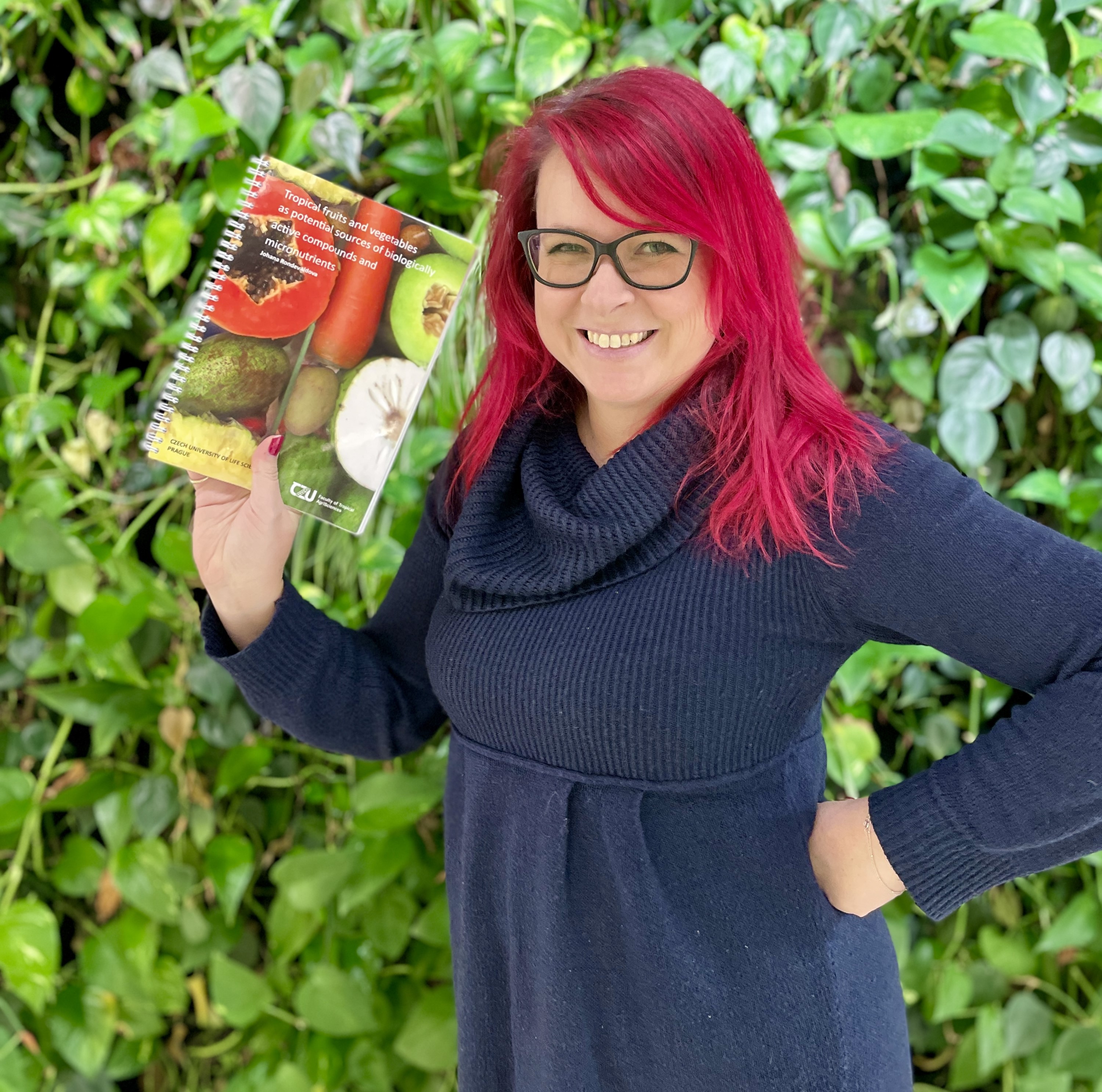Tropical Fruits and Vegetables: Rich Sources of Bioactive Compounds
Dr. Rondevaldová has been connected to the Faculty of Tropical AgriSciences since her undergraduate studies and focuses her research on the utilization of lesser-known plant species that can significantly contribute to addressing malnutrition and chronic diseases. At the same time, she navigates the challenges of translating her findings into practical applications. An interview with newly appointed Associate Professor Johana Rondevaldová offers an intriguing perspective on the potential of tropical fruits and vegetables as sources of biologically active compounds and essential micronutrients. The interview provides insights into the role of interdisciplinary collaboration and the importance of traditional knowledge in her work.
„I joined the faculty as an undergraduate student in 2006 and have been loyal to the faculty ever since. I have successfully completed my bachelor's, master's and doctoral studies here. After that I joined here as a postdoc, technical staff, and now I am working here as an assistant professor in the department of crop science and agroforestry,” says Johana Rondevaldová.
Tropical plants, especially fruits and vegetables, are valuable sources of nutrients, antioxidants, and other bioactive compounds with potential health benefits. These crops, including seaweeds, can significantly contribute to addressing global challenges such as food security, sustainable agriculture, and combating malnutrition. However, many of the species remain underutilized and their nutritional values and environmental connections often remain underexplored.
Current studies focus on the chemical composition, mineral and vitamin content, and antioxidant properties of these plants, while also examining changes in global consumption patterns and the role of ethical certifications like Fairtrade. The aim is not only to support the development of sustainable food systems but also to raise awareness about the social and ecological impacts associated with their production and consumption.
My habilitation thesis is a collection of research providing new insights to promote the awarness and broader use of tropical fruits and vegetables as healthy and sustainable food options.
Your research focuses on tropical fruits and vegetables as sources of biologically active compounds. Can you share examples of underutilized species that hold significant potential for addressing malnutrition or chronic diseases?
There are several such crops, but unfortunately, they are not well known in the world yet. First of all, it should be mentioned that underutilized species include not only plants, but also animals or seaweed, and even insects. Underutilized species have significant potential for addressing malnutrition and chronic diseases, especially as they often contain high levels of various essential micronutrients and bioactive compounds. By incorporating them into the diet, we can increase the intake of certain nutrients and at the same time increase the biodiversity of the food we consume. In addition, biologically active substances such as antioxidants can reduce the risk of the development of non-communicable diseases. Moreover, these plants are usually well adapted to different harsh conditions and can thus thrive, for example on marginalized soils or in arid areas, much better than major crops. A couple of species that have already gained a certain degree of popularity in last decades are, for example, acai berry (Euterpe oleracea), camu camu (Myrciaria dubia), moringa (Moringa oleifera), chayote (Sechium edule), or quinoa (Chenopodium quinoa). Most of these species are excellent sources of various vitamins (especially vitamin C) or high-quality protein, they provide also interesting amounts of essential minerals (e.g., calcium, iron, magnesium, potassium, zinc) and are often adapted to drought and tolerant to various pests and diseases.
What challenges do you face in translating your findings on bioactive compounds into practical applications, such as functional foods or supplements?
Major hurdles are especially related to pharmacokinetics, such as bioavailability. Many bioactive compounds demonstrate promising effects in vitro, but their effectiveness in humans depends on their bioavailability. Enhancing absorption and ensuring that the compound reaches its target site in the body is a complex task requiring advanced strategies. Another problem is related to possible toxicity of some bioactive compounds and their dosing, where it is necessary to determine precisely the concentrations that will be both effective and safe when administered. Many other challenges relate to the stability of these compounds, especially during processing, various legal regulations, cost-effectiveness, and consumer acceptability.
How do traditional knowledge and practices in tropical regions influence your research on identifying nutrient-rich plant species?
Traditional knowledge is essential in my research. Traditional diets and practices often reflect centuries of empirical observation. Communities have long identified nutrient-rich foods, healing herbs, and functional ingredients that promote health. Moreover, foods with roots in traditional knowledge are often culturally significant, and at the same time, indigenous knowledge is very vulnerable and quickly disappearing especially due to globalization. We therefore draw on this traditional knowledge in our research and work with local people to identify these plants and then analyze their nutritional potential in the laboratory.
Given the growing global demand for plant-based diets, how do tropical fruits and vegetables compare in nutritional value and market potential?
Tropical fruits have a high nutritional value and a very favorable market potential. Nutritionally, it is often rich in vitamins, minerals, fiber, and bioactive compounds - such as vitamin C or antioxidants. Many types of tropical fruit are in the leading positions of the total world fruit production, for example bananas, mangoes and pineapples are important commodities and sources of income for many tropical countries and the world production of tropical fruit and its share in world trade is increasing every year. In addition to fresh fruit, various products from these fruits are also available as food supplements rich in specific essential micronutrients or bioactive compounds. Nowadays, some underutilized fruits have become famous because of their excellent amount of certain micronutrinets and are now popular worldwide as a “superfruits” (e.g. camu camu or acai berry).
What role do you see for interdisciplinary collaborations—such as with chemists, nutritionists, or policy-makers—in maximizing the impact of your work on public health?
To transfer scientific knowledge into meaningful results in the field of nutrient-rich food and public health, interdisciplinary cooperation is absolutely necessary. Chemists help in identifying bioactive compounds, improving their stability, availability, and efficacy in various applications. Nutritionists provide critical insight into consumer eating habits and needs, bridging the gap between science and practical health advice. Market analysts, business experts, and economists can play a crucial role in raising awareness and driving demand for underutilized fruits. It is necessary to identify their market opportunities and develop specific strategies for their promotion. They can collaborate with policymakers to create incentives or subsidies for cultivating and marketing neglected fruits, increasing their visibility and market presence.
By working together, is the most effective way we can find solutions that have a real impact on food and nutrition security and public health.
Can you please highlight some of the manuscripts?
Among the recent articles that deal with the topic of tropical fruits and vegetables, I would like to mention these latest ones:
Determination of antioxidants, minerals and vitamins in Cambodian underutilized fruits and vegetables
This study investigated 22 underutilized fruits and vegetables from Cambodia to assess their antioxidant activity (DPPH and ORAC assays), total phenolic content, mineral composition (ICP-OES), and vitamin C and E levels (UHPLC-UV and HPLC-FLD). Results highlighted Limnophila aromatica as a standout with strong antioxidant activity and high mineral content (e.g., calcium, iron, magnesium). Other nutrient-rich plants include Sesbania javanica and Rhodomyrtus tomentosa (essential minerals) and Garcinia cochinchinensis and Pouteria campechiana (high in vitamins C and E). These findings suggest their potential as antioxidant- and nutrient-rich foods.
https://link.springer.com/article/10.1007/s11694-022-01630-9
Mineral composition of seaweeds and seagrasses of the Philippines
This study analyzed the mineral content of nine seaweeds and seagrasses from the Philippines, highlighting their potential as mineral-rich foods. Using ICP-OES, 23 minerals were quantified. Actinotrichia fragilis and Mastophora rosea were particularly high in calcium (21,511 and 14,100 mg/100 g DM, respectively), as well as copper, iron, manganese, and nickel. M. rosea also had the highest magnesium levels (2,093 mg/100 g DM). Other notable species include Enhalus acoroides (phosphorus), Halophila ovalis (silicon), Halymenia dilatata (zinc), Halymenia maculata (sulfur), and Portieria hornemannii (potassium and vanadium). These findings suggest their significant potential to enhance food and nutrition security.
https://www.tandfonline.com/doi/full/10.1080/00318884.2023.2183315
Antioxidant Activity and Total Phenolic Content of Underutilized Edible Tree Species of the Philippines
The study investigated the mineral and antioxidant content of underutilized fruits and vegetables, especially tree species, with emphasis on the potential of these crops as a source of essential minerals in human nutrition.
https://www.mdpi.com/2311-7524/10/10/1051
Assessing Consumer Interest in Sustainable and Ethically Certified Tropical Fruits in the Central and Eastern European Region
This study examined the potential for sustainable tropical fruit consumption in Central and Eastern Europe, surveying 2,266 Czech consumers on their preferences and the role of ethical certifications like Fairtrade in purchasing decisions. While bananas (99%), pineapples (94%), mangoes (78%), and avocados (65%) were the most popular fruits, the other species such as lichi, or dragon fruit are not much familiar for consumers. Moreover, only 42% of respondents recognized Fairtrade, with 55% expressing intent to buy it—often influenced by marketing rather than conscious choice. A structural equation model revealed that ethical shopping preferences and environmental awareness drive Fairtrade purchases, while economic and global issues had less impact. The study highlights the need for better consumer education on the social and economic benefits of ethical tropical fruits to ensure long-term sustainability.
https://www.mdpi.com/2077-0472/14/11/1962
What are your plans as new assoc. prof. at FTZ?
Of course I continue my activities as before, in research I am still dedicated to neglected and underutilized fruit and vegetable species, we are preparing another manuscript, this time on species from Ghana. I teach a total of six subjects in the bachelor's and master's study program and participate in the teaching of other subjects. This broad topic of neglected fruits and vegetables is also reflected in several ongoing bachelor's, master's, and doctoral theses under my supervision. Moreover, newly I ll be supervisor of online master's degree study program Tropical Agroecology. Now, I am expanding my research, especially on extraction methods and their influence on the final composition of the obtained extract. In the laboratory, we have unique equipment for green extraction, specifically for extraction with subcritical hot water (SHWE) or supercritical CO2. At this moment, we optimize the parameters of these extractions, especially time, temperature, pressure, to obtain the highest possible yields of bioactive substances and micronutrients. In addition, this topic is part of the Horizon project application, called Healthy food: plant-based for health. Within the submitted project, my team plans optimization of SHWE main parameters (time and temperature) for higher extraction yield of bioactive compounds, especially phenolics, from selected plant material (yellow pea, flax seed cake, Mediterranean herbs) with the aim of using these extracts as ingredients for minimally processed food. I would also like to expand the research related to the influence of SHWE by applying this method to various residues from fruit and vegetable processing because these waste or side stream products (such as fruit peel, seeds, or oilcakes) can be a rich source of micronutrients and biologically active substances that can be subsequently used in human nutrition or as extracts with pharmacological effects.
How does your family perceive your work commitment? How do you manage to create a balance between your personal and professional life?
I think my loved ones are happy that I'm doing what I like and enjoy. That's the most important thing. Of course, in any job it is sometimes difficult to combine family life with work. In my case, the biggest complication is probably the need to travel abroad for a long period of time, sometimes for several weeks, to collect data and plant material as part of my work. It's like with everything, sometimes it's easier sometimes it's a bit more difficult, but if you want to, you can balance it quite well. Our faculty is, in my experience, very family friendly and in case of the greatest necessity I can take my son to work without any problems and provide for his needs as well as the needs of our students and my research.


